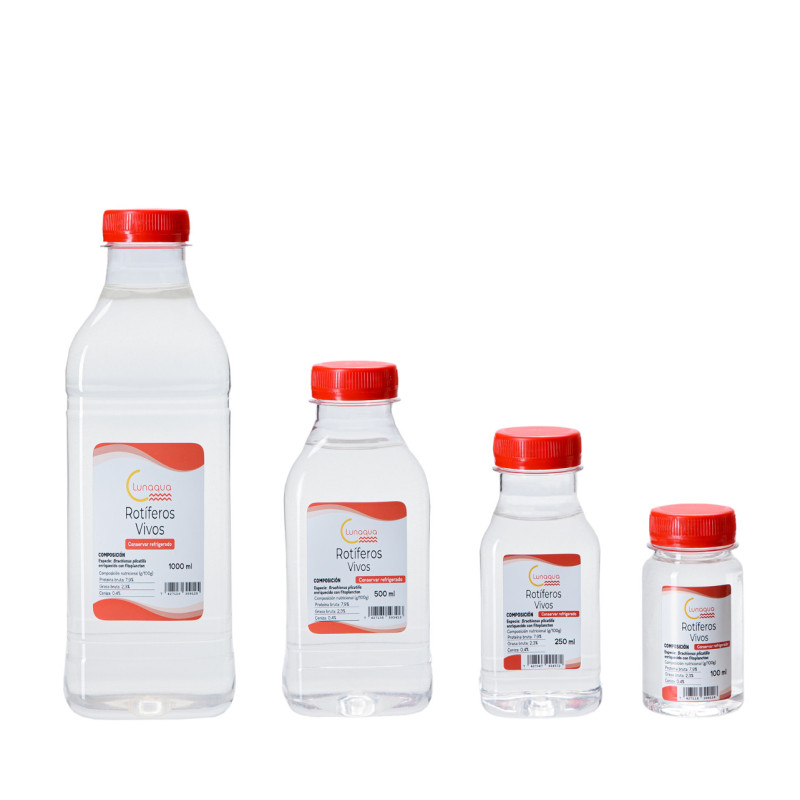More info
Genus: Brachionus
Kingdom: Animalia
Phylum: Rotifera
Class: Monogononta, Bdelloidea, Seisonidea
Family: Brachionidae
Kingdom: Animalia
Phylum: Rotifera
Class: Monogononta, Bdelloidea, Seisonidea
Family: Brachionidae
General characteristics
Microscopic organisms that are part of the plankton and play a fundamental role in the food chain of aquatic ecosystems.
Its name is due to the characteristic movement of these individuals, which have mobile cilia at the front end of the body that they use for locomotion.
They have a high reproductive rate and this makes them quickly occupy certain places or niches.
Tolerant to environments with different degrees of salinity, temperature, pH and low oxygen levels.
It has two types of reproduction, asexual (parthenogenetic) or sexual. Under unfavorable conditions they create resistance eggs that can remain dormant for long periods of time.
Its name is due to the characteristic movement of these individuals, which have mobile cilia at the front end of the body that they use for locomotion.
They have a high reproductive rate and this makes them quickly occupy certain places or niches.
Tolerant to environments with different degrees of salinity, temperature, pH and low oxygen levels.
It has two types of reproduction, asexual (parthenogenetic) or sexual. Under unfavorable conditions they create resistance eggs that can remain dormant for long periods of time.
Nutritional value
The biochemical composition and nutritional value of these organisms is directly related to the diet we feed them (Example: Feeding marine microalgae is not the same as feeding yeast).
The most used species of microalgae to feed them are Tetraselmis sp, Isochrysis sp and Chlorella sp. It is this phytoplankton that will provide the rotifer with adequate proteins, lipids and carbohydrates for its correct nutritional profile.
The rotifer itself does not have an adequate nutritional quality, it depends on how it is fed the days before its use. What their stomach stores and the eggs they have at that time is what gives them their characteristic nutritional value.
The most used species of microalgae to feed them are Tetraselmis sp, Isochrysis sp and Chlorella sp. It is this phytoplankton that will provide the rotifer with adequate proteins, lipids and carbohydrates for its correct nutritional profile.
The rotifer itself does not have an adequate nutritional quality, it depends on how it is fed the days before its use. What their stomach stores and the eggs they have at that time is what gives them their characteristic nutritional value.
Advantages of rotifers as food
-
It is ideal for food due to its small size, slow movement, ability to be suspended in the water column, and relative ease of cultivation at high densities.
-
The size range of this organism is suitable for most farmed fish, 125-260 µm, which is intermediate in size between microalgae (20 µm) and artemia nauplii (500 µm).
-
They have a high reproductive capacity. Under favorable conditions, they reproduce asexually, with females producing an egg within hours. They are able to reproduce when they are only one day old (unlike copepods or brine shrimp, which need 2-3 weeks).
-
Another advantage is that they support high densities in cultivation.
-
They support variable conditions in the environment in which they are found (temperature, pH, salinity, oxygen,...).
-
They have a slow movement that allows organisms with difficulties to feed on them in a simpler way.
-
By having a non-selective filtration (such as Artemia) they become ideal prey to be enriched as best suits us.
-
They are easily digestible.
-
Seawater is their most optimal medium but they live perfectly in a marine aquarium as they are capable of withstanding highly variable salinity ranges (1-97ppm).
When to use rotifers and what for
-
The rotifer is not the natural food for marine fish larvae. However, since it began to be used in Japan as the first larval food in 1965, it has become the most widely cultivated live food in intensive aquaculture. For all these reasons, it is widely used to feed fish larvae and marine crustaceans today.
-
It is indispensable as the first live food due to the fact that the Artemia nauplius is inaccessible to the larvae during the first days of life.
-
If our purpose is to create more zooplankton in our aquarium, we must add them at night so that they are not eaten immediately after adding them.
-
Widely used for feeding corals and fish larvae. It should be noted that it is especially recommended for breeding fish such as clownfish or seahorses since these have a very small mouth size and rotifers become the ideal prey for the development of these fish.
-
Ideal for feeding all the invertebrates in our aquarium: anemones, sponges, starfish,...
Reviews
No customer reviews for the moment.




